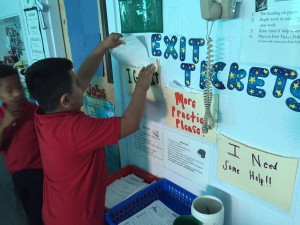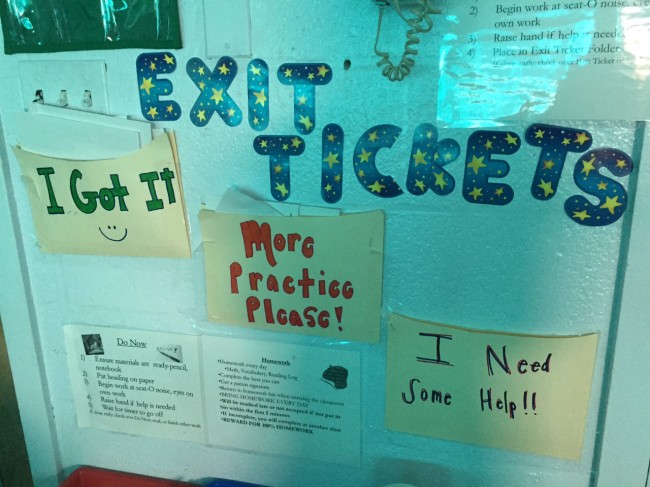10.13.15Exit Tickets that Encourage Self-reflection
 I’ve posted several times recently with guidance and reflections on Exit Tickets (here and here, for example. Or even here) but this morning I got a fascinating note from Leanne Riordan, who teaches are Holabird Academy in Baltimore. She wanted to share some clever ideas her colleagues are using to include a level of self-monitoring and self-reflection for students. She writes:
I’ve posted several times recently with guidance and reflections on Exit Tickets (here and here, for example. Or even here) but this morning I got a fascinating note from Leanne Riordan, who teaches are Holabird Academy in Baltimore. She wanted to share some clever ideas her colleagues are using to include a level of self-monitoring and self-reflection for students. She writes:
I’d like to chime in to the exit ticket conversation with an idea to encourage student reflection and develop metacognition in conjunction with the exit ticket. In my school I’ve noticed some teachers have the students turn their exit tickets into bins, based on the students’ own perception of their understanding. One bin might be something like “I’ve got this!” while another is labeled “More practice please.” In between could be “I need some help” or “I’m almost there.”
In addition to helping the students be more mindful about their outcomes at the end of the lesson, I think these piles can also help with buy-in later when you pull a group for corrective teaching. The teacher should reference that the students in the small group did not answer correctly, and they also asked for help. Or, if most of the class said they needed help, the teacher could open the next lesson with a connection to this purpose. Something like, “I noticed that most of the class asked for more help with __, so we are going to spend 10 minutes going over it again, in a different way that will help you understand it better.”
I also think it would be interesting to compare how the students rated their understanding vs. their actual performance. Are some overconfident, or not confident enough? Are the students able to correctly assess their level of knowledge or ability to problem solve? How do the student-created piles compare to the scored piles?
I am attaching a few of photo examples from Erika Savage’s third grade classroom.

Fascinating stuff, right? It’s neat that teachers don’t RELY on self-report –they still get the objective data–but gather additional information that can be a tool that can foster conversations among teachers and with students about the correlation between student’s perception of their own mastery and what the exit tickets show. Or, as Leanne pointed out, you could even follow up with process-oriented diagnostic questions for students who report they need more help (“WHY do you think you did not get it the first time? Were you actively listening? Did you take careful notes? Can I see them?” Etc.)
Anyway, thanks to Leanne and her colleagues at Holabird for sharing.

Inspired! Thank you for psyching me to teach like a champion. EXIT slips were an academic goal I put into practice in my 5th grade classroom this year. Each student has a designated pocket on the bulletin board by the door, so that on their way out the ticket can be placed. Good, but then I see this idea on EXIT slips and think…WHY didn’t I think of that?! It would have been more cost effective for me, and totally supportive of students being evermore mindful of their performance.
Sometimes it’s such a simple tweak to an idea that can make such big differences. Thanks.
Agreed, Janice. Thanks. Glad it was useful.